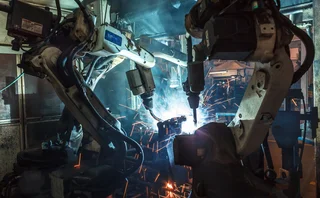Anthony Malakian: Gregg Berman’s Gedankenexperiment for Market Structure
The SEC's Gregg Berman provided a thought experiment to explain how today’s market structure has evolved.

Gedanken is the German word for thought, so a Gedankenexperiment (yes, it's spelled as one word) is an experiment that is carried out in thought only. Notable examples include Albert Einstein and chasing a beam of light, or Erwin Schrödinger's cat paradox.
At this year's North American Trading Architecture Summit, Gregg Berman, associate director in the US Securities and Exchange Commission's Office of Analytics and Research, decided to take those in attendance on a similar journey to better understand today's market structure.
To start, let's assume that we have one market, but with many instruments to rid ourselves of the idea of fragmentation. Let's also jettison the OTC industry, so everybody trades in one and only one place. It's also a diverse market with retail and institutional investors of all different shapes, sizes and strategies. And assume that you have a large number of liquidity providers. Finally, let's put everybody into one of only two camps: liquidity provision or fundamental buying-and-selling.
In this Gedankenexperiment model, large and small traders hold the same power. A large trader may need 100,000 Microsoft shares, they go out and get them, but they pay a premium because they have to get more into the depth of book, according to Berman.
Curveball
Now we introduce a variable. This world is based on the fact that orders are coming in at a random sequence-that's how market-makers know where to place their spreads, because if there's a small order to buy, the probability is 50/50 that the next order will be a buy or a sell. But let's say that one smart broker-dealer decides to take an order for 200,000 IBM shares and split that up into little bits-98 shares, 100 shares, 103 shares, etc.
If one person does that on occasion for one stock, Berman says, then all of those small orders get lost in the noise of all the other random small orders, and market-makers leave their algorithms exactly where they were. But what happens when everyone starts employing execution algos and no one actually shows their order size?
If one person does that on occasion for one stock, Berman says, then all of those small orders get lost in the noise of all the other random small orders, and market-makers leave their algorithms exactly where they were. But what happens when everyone starts employing execution algos and no one actually shows their order size? A market-maker's entire premise is built on that randomness where if an order enters the market for 100 shares, there's a 50/50 chance that the next order will be long or short.
"If people are using a lot of execution algos, there's a very high probability that every time I see an order for 100, 200 or 300 [shares], the next order will be 100, 200 or 300," Berman says. "That completely changes the dynamic of where they're going to put their bid-ask spread."
Long-term Strategies
Now, by their nature, traditional asset managers, pension plans and retail investors use long-term strategies, and for this exercise, long-term means anything more than 15 minutes, Berman says. When it comes to 15-plus minutes, you could be trading on news.
"What breaks that, and what makes an asset manager informed, is that they have a piece of information that no one else on the planet has," Berman says. "They put in an order for 100 shares and they know that they have another 50 of those coming in the next 15-50 seconds. That's what makes asset managers informed traders-they have a piece of information that will directly affect the market immediately after they place that first order. That dynamic of chopping up orders and placing them, and how market-makers have to change their algos, I believe is the root of what has actually happened to market structure today.
In this thought experiment, even if you have a single market, it's the interaction between execution algos and market-making algos that generates the idea of having to continuously place orders and then cancel them, place orders and then cancel them," Berman says.
So what's the answer? There isn't one ... this is a thought experiment, after all. The cures are going to have to come from somewhere else. Maybe a regulator?
Only users who have a paid subscription or are part of a corporate subscription are able to print or copy content.
To access these options, along with all other subscription benefits, please contact info@waterstechnology.com or view our subscription options here: https://subscriptions.waterstechnology.com/subscribe
You are currently unable to print this content. Please contact info@waterstechnology.com to find out more.
You are currently unable to copy this content. Please contact info@waterstechnology.com to find out more.
Copyright Infopro Digital Limited. All rights reserved.
As outlined in our terms and conditions, https://www.infopro-digital.com/terms-and-conditions/subscriptions/ (point 2.4), printing is limited to a single copy.
If you would like to purchase additional rights please email info@waterstechnology.com
Copyright Infopro Digital Limited. All rights reserved.
You may share this content using our article tools. As outlined in our terms and conditions, https://www.infopro-digital.com/terms-and-conditions/subscriptions/ (clause 2.4), an Authorised User may only make one copy of the materials for their own personal use. You must also comply with the restrictions in clause 2.5.
If you would like to purchase additional rights please email info@waterstechnology.com
More on Emerging Technologies
Bloomberg expands GenAI summary options on Terminal
The additions include an expansion of its AI-powered news summaries, as well as a new AI summary tool for company-related news content.
AI enthusiasts are running before they can walk
The IMD Wrap: As firms race to implement generative and agentic AI, having solid data foundations is crucial, but Wei-Shen wonders how many have put those foundations in.
Buy-side data heads push being on ‘right side’ of GenAI
Data heads at Man Group and Systematica Investments explain how GenAI has transformed the quant research process.
Jump Trading spinoff Pyth enters institutional market data
The data oracle has introduced Pyth Pro as it seeks to compete with the traditional players in market data more directly.
Treasury market urged to beef up operational resilience plans
NY Fed panel warns about impact of AI and reliance on critical third parties.
Waters Wavelength Ep. 339: Northern Trust Asset Management’s Jan Rohof
This week, Jan Rohof from Northern Trust Asset Management joins to discuss how asset managers and quants get more context from data.
EY and Microsoft partner to bring agentic AI to risk management
The two firms are part of a deal to bring agentic AI processes to core operations like lending, servicing and risk, starting at Eurobank.
T. Rowe taps Genesis, Cusip lawsuit, FanDuel-CME tie-up, and more
The Waters Cooler: Tokenization and private markets, EuroCTP-BMLL, StateStreet-PriceStats, and more.








